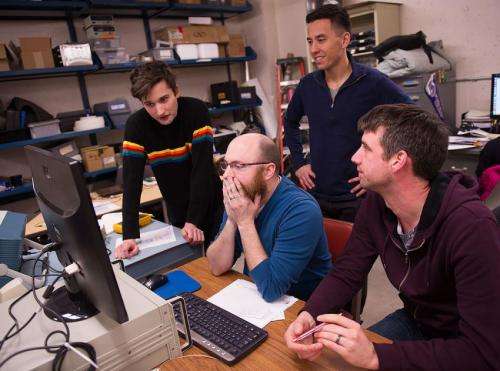UI researchers launch rockets in search of unseen parts of universe

Walk into the corner astronomy lab in the basement of Van Allen Hall, and you'll likely hear a student spontaneously burst into song while creating preliminary computer aided designs for an upcoming NASA project proposal. Or, find a former-accountant-turned-astronomer designing circuit boards and routing cables through the colorfully exposed electronic guts of a rocket payload.
The lab is home to a team of seven undergraduate and graduate students, assembled by astronomy and physics associate professor Randy McEntaffer to launch a series of NASA rockets. Over the din of donut-induced sarcasm, they take a moment to discuss the merits of a good project acronym: if OGRE launches third, and OGRESS launches second, should OGLETTE launch first?
It's easy to see that the team is driven and uniquely-talented. What they're searching for in space, however, is a little harder to pin down.
McEntaffer is the principal investigator (PI) on a suborbital rocket project to develop critical technologies for future NASA missions. The lab is building the first of three payloads whose instruments will be able to see the missing normal matter in space that is not currently observable with telescopes or the naked eye.
The matter the team hopes to eventually see makes up the intergalactic medium - the hot, sparse plasma (10^5 to 10^7° K) that takes up the space between the galaxies. It's where astronomers believe that a large fraction of the universe's normal matter—atomic and baryonic, rather than dark matter - exists. Astronomers also believe that the matter reflects x-ray light, rather than the longer wavelengths of the visible light spectrum.
"If we can detect the absorption caused by the intergalactic medium, then we will have discovered upwards of 50 percent of all the normal matter in space," McEntaffer says.
That goes a long way toward confirming the current models of the universe, McEntaffer says. Astronomers are able to predict the amount of matter that should exist in the universe, and they need those predictions to be backed up by real observations, which is a continuing process.
To see the unseen, the team is building an observational system using x-ray diffraction gratings—tiny zig-zag patterns cut into pieces of silicone—that can break apart the x-ray light itself, diffracting it. Just as refracting visible light through a prism reveals the colors of the rainbow, diffracting x-ray light off the gratings produces the "x-ray rainbow," McEntaffer says. The x-ray rainbow won't show up if the x-ray light simply passes over a flat surface, but when it hits the repeating zig-zag of the grating, the x-ray light creates an interference pattern, displaying the relative "colors" that make up x-ray light.
From there, "you can tell the physical properties of what you're looking at, which you can't tell from a pretty picture, or a single point of light," McEntaffer says.
For the team's upcoming rocket missions, the makeup of the x-ray rainbow is captured either by a gaseous electron-multiplying (GEM) detector, or a charge-coupled device camera, depending on the size of the observed object. The data is then sent back down to Earth.
The team's first project, the Off-plane Grating Rocket for Extended Source Spectroscopy (OGRESS) and second project, the Off-plane Grating Rocket Experiment (OGRE) will comprise three rocket launches—the first of which happens this spring. Two more will follow in 2016 and 2018.
If the missions are successful, the team hopes to secure a NASA proposal to put a similar instrument setup on the International Space Station. It means a great amount progress for astronomers' understanding of the universe, but it also means a tremendous amount of experience for the students involved. Because the missions they fly don't involve people, students are able to work directly on the rocket's electronics, a rare thing for undergraduate and graduate students, McEntaffer says.
"Really, this the only way to get hardware training in space-based astronomy. The rocket program trains undergraduates, graduates, post docs, engineers, all the way through young PIs, like myself. For me, it's preparing for the next mission. We're all getting ready for that next role in that next mission," McEntaffer says.
McEntaffer is the principal investigator on this five-year collaboration with NASA. The diffraction gratings are built by students at the Optical Science and Technology Center inside the Iowa Advanced Technology Laboratories at the University of Iowa. The mission is funded by NASA and incorporates optics from Goddard Space Flight Center and a CCD camera from collaborators at the Open University in the UK.
Project Timeline:
March 9, 2015:McEntaffer, project engineer Ted Schultz, and project scientist Thomas Rogers travel to Wallops Flight Facility in Virginia to spend four weeks integrating their payload into the NASA rocket.
April 13, 2015: The group travels from Wallops to White Sand Missile Range in New Mexico to prepare for launch.
May 5, 2015: The first OGRESS rocket launches. It spends five minutes observing the supernova remnant Cygnus Loop, an exploding star nearly 1,500 light years away from Earth.
2016:OGRESS flies again. This time, the rocket launches from Australia and observes the supernova remnant Vela, 800 light years away.
2018:The third rocket payload, OGRE, will launch and observe the binary star system Capella, the sixth brightest star in the night sky, 42 light years away."A full one-third to one-half has yet to be found from this theoretical model that defines our whole universe. To define this last bit, that's huge for understanding the universe," McEntaffer says.
Provided by University of Iowa



















